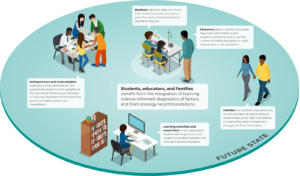The Research Base for Formative Assessment

By Mary Ryerse and Susan Brookhart
Formative assessment is at the forefront of many education conversations and, at present, many accept intuitively that it’s an important part of the learning process.
Yet, how do we know formative assessment actually works? In this blog, we unpack some of the research base underlying the practice of formative assessment.
For those less familiar with the practice, it is important to note that formative assessment is a process in which students and teachers work together to improve learning. Both students and teachers are active participants in the process as they generate, interpret, and use evidence of learning to 1) aim for learning goals, 2) apply criteria to the work they produce, and 3) decide on next steps.
To summarize the process, there is a formative learning cycle which encourages students to repeatedly ask these three questions:
- Where am I going?
- Where am I now?
- Where to next?
Further, formative assessment is not a particular kind of test, or marks or grades, but rather an ongoing practice.
Below, we have synthesized key information about research behind formative assessment’s effectiveness.
Foundational Research Base for Formative Assessment
The original research base on formative assessment is most typically traced back to the 1998 publication Assessment and Classroom Learning (Black & Wiliam, 1998), the first widely cited review of literature on formative assessment in the English language. The researchers found “firm evidence” that formative assessment can work, but also noted that there was not much formative assessment happening in conventional teaching practices (more on that later).
Much of the research measures whether a particular practice is working by the “effect size.”
Definition:
“Effect size is the difference between treatment group and comparison group expressed in standard deviation units.” Generally speaking, the higher the effect size the stronger the evidence of impact.
In the Black and Wiliam review, the authors cited prior studies reporting effect sizes that ranged from 0.40 and 0.70 for formative assessment practice, a relatively strong indicator. Evidence for those numbers came mostly from a 1986 review of formative assessment in special education titled Effects of Systematic Formative Evaluation: A Meta-Analysis (Fuchs & Fuchs, 1986).
In an effort to increase classroom practice, Black and Wiliam also created a “practitioner’s summary,” Inside the Black Box: Raising Standards through Classroom Assessment, to go along with the original pub.
More Recent Reports and Critiques.
A number of studies followed the foundational research of Black and Wiliam. These more recent reports justified a need for more research, a critique of current research and a need for content-area-specific research.
A call for research. More recently, Formative Assessment: A Meta-Analysis and a Call for Research, (Kingston & Nash, 2011) estimated the effect size in the 0.20 to 0.30 range. Regardless, the findings point to a significant level of impact.
A critical review. There is some criticism of research that lumps all formative assessment together because formative assessment is so complex. It encompasses many different practices and usually takes place in a context of other changes, as well (for example, a change to more student-centered learning in general). Bennett’s Formative Assessment: A Critical Review (2011) is the most widely cited and best articulated of the critiques.
A look across content areas. It may be that in the future, the best evidence of the effects of formative assessment on learning will be accumulated through studies within content areas, which removes some of the complexity among a group of studies. In Formative Assessment and Writing (Graham, Hiebert, & Harris, 2015), a review of formative assessment specifically assessing the effects on students learning to write, was conducted and found average effect sizes of 0.87, 0.62, 0.58, and 0.38 for feedback from adults, self, peers, and computers, respectively. These effect sizes point to the importance of emphasizing specific content area feedback and assessment.
Closely Connected: Effects of Feedback
Additionally, evidence for the effects of formative assessment also comes from the much larger literature on the effects of feedback. Feedback is one of the foundational aspects of formative assessment. Recent reviews of the feedback literature include the following:
- The Power of Feedback (Hattie & Timperley, 2007). Summarizing previous meta-analyses of the effects of feedback, this review found an overall effect size of 0.79, which placed it among the top 5 or 10 influences of any kind on achievement.
- Effects of Feedback in a Computer-Based Learning Environment on Students’ Learning Outcomes (Van der Kleij, Feskens, & Eggen, 2015). This review reported effect sizes of 0.49 for elaborated feedback (feedback that includes explanations, additional material, and/or suggestions for next steps) in the context of computer-based instruction.
- Focus on Formative Feedback (Shute, 2008). This report provided a more descriptive review of the literature on task-level, formative feedback, and four summary tables of recommendations for practice based on the research reviewed.
Policy Brief
It has been demonstrated that students become active agents in their educational process as they learn how to use feedback, set goals, monitor their own progress and select strategies that move their own learning forward. According to Formative Assessment: Improving Learning in Secondary Classrooms, formative assessment practice has been shown to be highly effective in raising the level of student attainment, increasing equity of student outcomes and improving students’ ability to learn.
The above-mentioned policy brief is an executive-summary-style brief of a larger study (OECD, 2005) that was part of OECD’s “What Works in Innovation in Education” initiative. The report reviews international research as well as OECD’s case study findings, presents case studies from several schools in eight participating countries, and includes English, French, and German literature reviews on formative assessment in their respective contexts and research traditions.
Additional findings include that schools which use formative assessment show not only general gains in academic achievement but also particularly high gains for previously underachieving students.
It is worth noting that teachers help students accomplish the above and move learning forward. According to the same OECD report, teachers who engage in formative assessment report a changed classroom culture, clarity regarding goals, varied instructional practices and more positive interactions with students.
As we see that the more general research has revealed positive effects and benefits of formative assessment, it seems clear that more specific research will only refine and improve the practice.
For more, see:
- Scaling Formative Assessment: The How I Know Project
- Keys to Success for Formative Assessment: A Professional Learning Guide
- Reflections on How I Know
Susan Brookhart is a formative assessment expert who speaks, writes and consults through Brookhart Enterprises LLC (susanbrookhart.com).
Stay in-the-know with all things EdTech and innovations in learning by signing up to receive the weekly Smart Update.







0 Comments
Leave a Comment
Your email address will not be published. All fields are required.